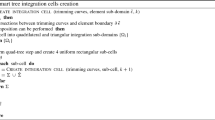Abstract
This paper describes an automatic and robust approach to convert non-manifold CAD assemblies into unstructured all-hexahedral meshes conformal to the given B-Reps (boundary-representations) and with sharp feature preservation. In previous works, we developed an octree-based isocontouring method to construct unstructured hexahedral meshes for arbitrary non-manifold and manifold domains. However, sharp feature preservation still remains a challenge, especially for non-manifold CAD assemblies. In this paper, boundary features such as NURBS (non-uniform rational B-Splines) curves and surface patches are first extracted from the given B-Reps. Features shared by multiple components are identified and distinguished. To preserve these non-manifold features, one given surface patch may need to be split into several small ones. An octree-based algorithm is then carried out to create an unstructured all-hexahedral base mesh, detecting and preserving all the sharp features via a curve and surface parametrization. Two sets of local refinement templates are provided for adaptive mesh generation, along with a novel 2-refinement implementation. Vertices in the base mesh are categorized into four groups based on the given non-manifold topology, and each group is relocated using various methods with all sharp features preserved. After this stage, a novel two-step pillowing technique is developed for such complicated non-manifold domains to eliminate triangle-shaped quadrilateral elements along the curves and “doublets”, handling non-manifold and manifold features in different ways. Finally, a combination of smoothing and optimization is used to further improve the mesh quality. Our algorithm is automatic and robust for non-manifold and manifold domains. We have applied our algorithm to several complicated CAD assemblies.





















Similar content being viewed by others
References
Blacker T, Myers R (1993) Seams and wedges in plastering: a 3D hexahedral mesh generation algorithm. Eng Comput 2(9):83–93
Clark B, Hanks B, Ernst C (2008) Conformal assembly meshing with tolerant imprinting. In: Proceedings of 17th International Meshing Roundtable, pp 267–280
Ebeida M, Patney A, Owens J, Mestreau E (2010) Isotropic conforming refinement of quadrilateral and hexahedral meshes using two-refinement templates. Int J Numer Methods Eng (accepted)
Folwell N, Mitchell S (1999) Reliable whisker weaving via curve contraction. Eng Comput 15(3):292–302
Garland M, Heckbert P (1998) Simplifying surfaces with color and texture using quadric error metrics. In: Proceedings of the conference on Visualization, pp 263–269
Ito Y, Shih A, Soni B (2009) Octree-based reasonable-quality hexahedral mesh generation using a new set of refinement templates. Int J Numer Methods Eng 77(13):1809–1833
Edgel J (2010) An adaptive grid-based all hexahedral meshing algorithm based on 2-refinement. Master Thesis, Brigham Young University
Knupp P (1998) Next-generation sweep tool: a method for generating all-hex meshes on two-and-one-half dimensional geometries. In: Proceedings of 7th International Meshing Roundtable, pp 505–513
Knupp P (2000) Achieving finite element mesh quality via optimization of the Jacobian matrix norm and associated quantities. Part II–A framework for volume mesh optimization and the condition number of the Jacobian matrix. Int J Numer Methods Eng 48(8):1165–1185
Marechal L (2009) Advances in octree-based all-hexahedral mesh generation: handling sharp features. In: Proceedings of 18th International Meshing Roundtable, pp 65–84
Mitchell S, Tautges T (1995) Pillowing doublets: refining a mesh to ensure that faces share at most one edge. In: Proceedings of 4th International Meshing Roundtable, pp 231–240
Owen S (1998) A survey of unstructured mesh generation technology. In: Proceedings of 7th International Meshing Roundtable, pp 26–28
Owen S, Shepherd J (2009) Embedding features in a cartesian grid. In: Proceedings of 18th International Meshing Roundtable, pp 117–138
Price M, Armstrong C (1995) Hexahedral mesh generation by medial surface subdivision: Part I. Int J Numer Methods Eng 38(19):3335–3359
Price M, Armstrong C (1997) Hexahedral mesh generation by medial surface subdivision: Part II. Int J Numer Methods Eng 40(1):111–136
Qian J, Zhang Y, Wang W, Lewis A, Qidwai M, Geltmacher A (2010) Quality improvement of non-manifold hexahedral meshes for critical feature determination of microstructure materials. Int J Numer Methods Eng 82(11):1406–1423
Schneiders R (1996) A grid-based algorithm for the generation of hexahedral element meshes. Eng Comput 12(3-4): 168–177
Schneiders R, Schindler R, Weiler F (1996) Octree-based generation of hexahedral element meshes. In: Proceedings of 5th International Meshing Roundtable, pp 205–216
Shepherd J (2009) Conforming hexahedral mesh generation via geometric capture methods. In: Proceedings of 18th International Meshing Roundtable, pp 85–102
Qian J, Zhang Y (2010) Sharp feature preservation in octree-based hexahedral mesh generation for CAD assembly models. In: Proceedings of 19th International Meshing Roundtable, pp 243-262
Shepherd J, Zhang Y, Tuttle C, Silva C (2007) Quality improvement and boolean-like cutting operations in hexahedral meshes. The 10th ISGG Conference on Numerical Grid Generation. FORTH, Crete, 16–20 Sept 2007
Staten M, Kerr R, Owen S, Blacker T (2006) Unconstrained paving and plastering: progress update. In: Proceedings of 15th International Meshing Roundtable, pp 469–486
Tautges T, Blacker T, Mitchell S (1996) The whisker-weaving algorithm: a connectivity based method for constructing all-hexahedral finite element meshes. Int J Numer Methods Eng 39(19):3327–3349
Zhang Y, Bajaj C (2006) Adaptive and quality quadrilateral/hexahedral meshing from volumetric data. Comput Methods Appl Mech Eng 195(9–12):942–960
Zhang Y, Bajaj C, Sohn B (2005) 3D finite element meshing from imaging data. The special issue of Computer Methods in Applied Mechanics and Engineering on Unstructured Mesh Generation 194(48–49):5083-5106
Zhang Y, Hughes T, Bajaj C (2010) An automatic 3D mesh generation method for domains with multiple materials. Comput Methods Appl Mech Eng 199 (5–8):405–415
Acknowledgments
We would like to thank Wenyan Wang for useful discussions on NURBS curve and surface parametrization, and Matt Staten for providing the multi-axis, hook2, hook and varco3 models. The research was supported in part by Y. Zhang’s ONR-YIP award N00014-10-1-0698, an ONR grant N00014-08-1-0653, and a NRL contract N00173-08-C-6011 as part of the HPCMP CREATE program.
Author information
Authors and Affiliations
Corresponding author
Additional information
A preliminary version of this paper was published in the 19th International Meshing Roundtable conference [20].
Rights and permissions
About this article
Cite this article
Qian, J., Zhang, Y. Automatic unstructured all-hexahedral mesh generation from B-Reps for non-manifold CAD assemblies. Engineering with Computers 28, 345–359 (2012). https://doi.org/10.1007/s00366-011-0232-z
Received:
Accepted:
Published:
Issue Date:
DOI: https://doi.org/10.1007/s00366-011-0232-z




